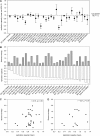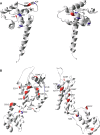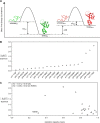Frequent and variable cytotoxic-T-lymphocyte escape-associated fitness costs in the human immunodeficiency virus type 1 subtype B Gag proteins
- PMID: 23365420
- PMCID: PMC3624202
- DOI: 10.1128/JVI.03233-12
Frequent and variable cytotoxic-T-lymphocyte escape-associated fitness costs in the human immunodeficiency virus type 1 subtype B Gag proteins
Abstract
Cytotoxic-T-lymphocyte (CTL) escape mutations undermine the durability of effective human immunodeficiency virus type 1 (HIV-1)-specific CD8(+) T cell responses. The rate of CTL escape from a given response is largely governed by the net of all escape-associated viral fitness costs and benefits. The observation that CTL escape mutations can carry an associated fitness cost in terms of reduced virus replication capacity (RC) suggests a fitness cost-benefit trade-off that could delay CTL escape and thereby prolong CD8 response effectiveness. However, our understanding of this potential fitness trade-off is limited by the small number of CTL escape mutations for which a fitness cost has been quantified. Here, we quantified the fitness cost of the 29 most common HIV-1B Gag CTL escape mutations using an in vitro RC assay. The majority (20/29) of mutations reduced RC by more than the benchmark M184V antiretroviral drug resistance mutation, with impacts ranging from 8% to 69%. Notably, the reduction in RC was significantly greater for CTL escape mutations associated with protective HLA class I alleles than for those associated with nonprotective alleles. To speed the future evaluation of CTL escape costs, we also developed an in silico approach for inferring the relative impact of a mutation on RC based on its computed impact on protein thermodynamic stability. These data illustrate that the magnitude of CTL escape-associated fitness costs, and thus the barrier to CTL escape, varies widely even in the conserved Gag proteins and suggest that differential escape costs may contribute to the relative efficacy of CD8 responses.
Figures





References
-
- Safrit JT, Andrews CA, Zhu T, Ho DD, Koup RA. 1994. Characterization of human immunodeficiency virus type 1-specific cytotoxic T lymphocyte clones isolated during acute seroconversion: recognition of autologous virus sequences within a conserved immunodominant epitope. J. Exp. Med. 179:463–472 - PMC - PubMed
-
- Goonetilleke N, Liu MK, Salazar-Gonzalez JF, Ferrari G, Giorgi E, Ganusov VV, Keele BF, Learn GH, Turnbull EL, Salazar MG, Weinhold KJ, Moore S, Letvin N, Haynes BF, Cohen MS, Hraber P, Bhattacharya T, Borrow P, Perelson AS, Hahn BH, Shaw GM, Korber BT, McMichael AJ. 2009. The first T cell response to transmitted/founder virus contributes to the control of acute viremia in HIV-1 infection. J. Exp. Med. 206:1253–1272 - PMC - PubMed
-
- Schmitz JE, Kuroda MJ, Santra S, Sasseville VG, Simon MA, Lifton MA, Racz P, Tenner-Racz K, Dalesandro M, Scallon BJ, Ghrayeb J, Forman MA, Montefiori DC, Rieber EP, Letvin NL, Reimann KA. 1999. Control of viremia in simian immunodeficiency virus infection by CD8+ lymphocytes. Science 283:857–860 - PubMed
Publication types
MeSH terms
Substances
Grants and funding
LinkOut - more resources
Full Text Sources
Other Literature Sources
Research Materials

